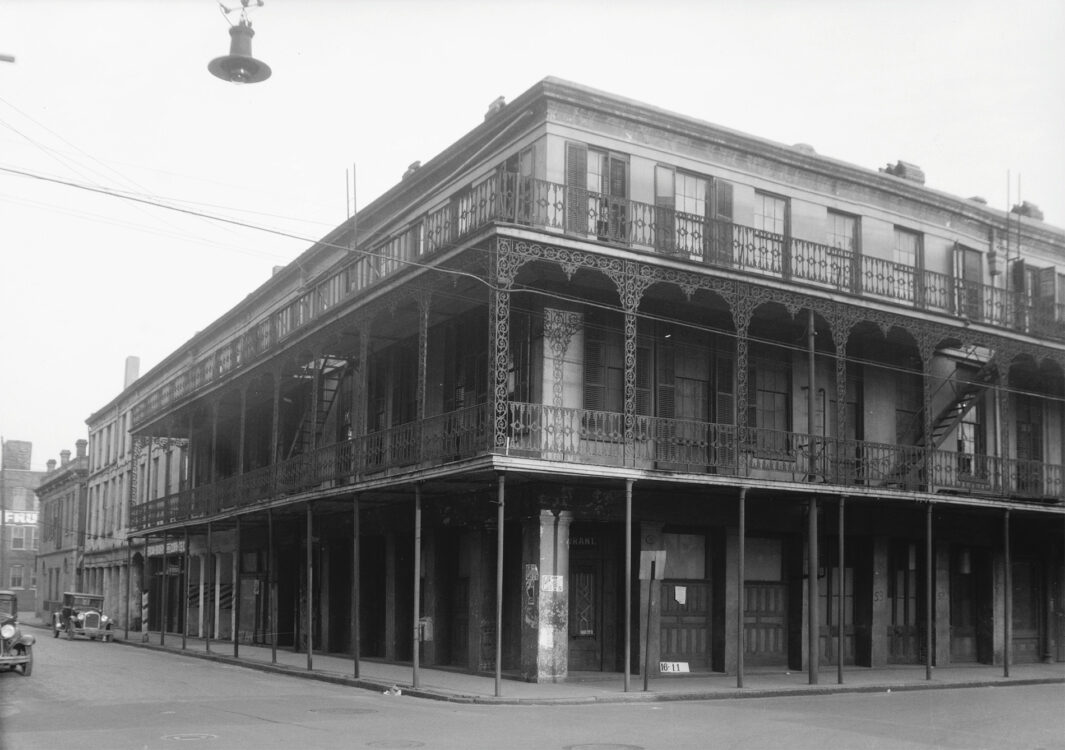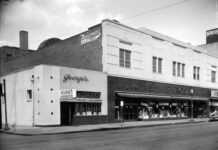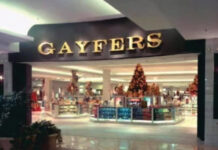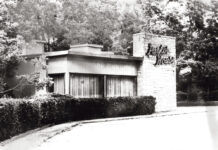
One of Mobile’s early hotels opened its doors in 1837 as the Gulf City Hotel. It originally was a relatively small structure on the south east corner of Water and Conti streets. The location was convenient to various businesses along Water Street and was a short walk to the riverfront docks.
Mobile was on the brink of explosive growth and the much larger Battle House would be completed in 1852. Somewhere in that decade, the Gulf City Hotel was greatly enlarged and adorned with an elaborate set of cast iron galleries.
The Gulf City Hotel was apparently competitive enough with the newer Battle House to be selected for an important banquet in January of 1873. A group of prominent men sent out invitations to a selected list of Mobilians to discuss the creation of a new men’s social club.
A menu, written in French, survives. The hotel apparently had quite a staff, as the meal included oysters on the half shell followed by a choice of glazed ham, roast duck, partridge, veal, pate, chicken, stuffed oysters and a selection of pickles. To quench the men’s thirst, they could choose from white or red wine, sherry or Champagne. There were three different cakes for dessert as well as a selection of fresh fruit including oranges and what would have been an expensive novelty: bananas.
The meal was a success. The Athelstan Club was formed as a result and still operates today as the oldest private club in the state.
Two years later, the hotel advertised itself as “a well-known and popular house” with rates of $3 per day, $15 per week or $45 per month. In today’s dollars, that would equate to $90 per day, $450 for the week and a bit over $1,300 for a month’s stay. Another line of advertising termed it “A First Class Hotel with Second Rate Prices.”
By the early 1890s, the hotel had ceased to operate as a hotel. Its 1893 listing offered furnished rooms in the “Gulf City Hotel building” with no mention of hotel services. It was obviously time for some upgrades.
The Southern Hotel Arrives
In 1894, the hotel was remodeled and reopened as the Southern Hotel. It is unclear why that name was selected as hotels with that same name existed in Meridian, Birmingham, Guntersville and Chattanooga, with no obvious connection to the Mobile hotel.
John T. McNamara took over the hotel and advertised it as the “only European hotel in the city.” His advertisements, which appeared in newspapers around the state, noted that it was “Newly Furnished, Centrally Located, Meals First Class, Splendid Rooms, Porters at Train and electric Bells.”
The mention of providing porters at the train station recalls this memory from 1883: “For years every train was met by a small army of men who virtually laid siege to the station from the moment the first incoming passenger reached the platform. The porters’ job was to direct arriving passengers to the hotel of his employment.”
The mention of “electric bells” might be confusing, but they had been a happy solution to previous methods of calling for hot water from a porter. In those days before indoor plumbing, men had routinely opened their doors and yelled for what they wanted. The luxury of pressing a bell was a welcome addition to the better hotels for all concerned.
Competition to the West
As the new century arrived, so did competition. The first blow was in 1901 with the opening of the six-story Bienville Hotel on the north side of Bienville Square. It included verandas overlooking the square, a roof garden, billiard room, barber shop, rathskellar, and a dining room decorated in “old English.” Every two guest rooms shared a bath, and one news account stated that the hotel had “the best sanitary plumbing and ventilation throughout.”
In 1907, the Cawthon Hotel arrived on the west side of the square, offering all of those amenities as well as a glass-enclosed roof garden. The new Battle House, completed a year later, was even more luxurious.
From Gambling Den to Worse
No further modernization efforts could be uncovered for the Southern Hotel and it lost whatever luster it had enjoyed in its history. In 1911, the police raided the place after a tip off that it was being used for gambling operations. The culprits slipped out, leaving a valise containing some $500, or over $17,000 in today’s value.
Following World War I, the hotel changed its name to the swankier sounding Savoy Hotel. It apparently did not help, for in 1919, a local judge ordered that the owner and manager of the hotel would be arrested if things were not cleaned up. This time gambling was not the issue but rather the world’s oldest profession. The judge termed it “an immoral place…frequented by immoral women.”
It held on as the Savoy until 1926, and the following years was listed as offering furnished rooms as The Southern. When a photographer from the Historic American Buildings Survey photographed the former hotel in 1934, it had been sitting vacant since 1930.
Its interior revealed the simple architectural details popular in the 1830s, but a grimy and sadly abandoned space. The wreckers arrived in 1934 and the ironwork was obtained by architect George Rogers for a client down on the Fowl River: Walter Bellingrath. Its elaborate design may be seen today on his home which was built the following year.
Today, this historic corner no longer exists. Conti Street was infilled east of Royal Street with the Riverview complex and parking garage, and South Water Street is a much widened and traffic-filled highway.





